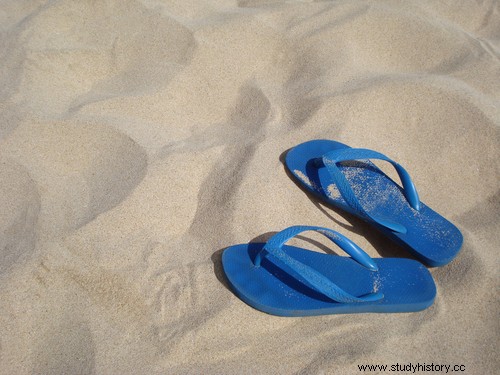
From time to time, some products manage to overcome the field from simple market competition to permeate our routine. Its insertion power even promotes the creation of new metonymies that, in this case, lead us to invert a product for its brand. Among so many cases, we can point out that Havaianas occupy this privileged position when it comes to the clothing of our feet.
Created in 1962 by the company Alpargatas , this sandal model appeared in the Brazilian consumer market through an advertisement with a strong utilitarian trait. Instead of emphasizing some aesthetic aspect, the first Havaianas advertisements emphasized the fact that the sandal doesn't smell, doesn't deform or loosen the straps . Interestingly, use value was suggestively placed above exchange value.
According to some researchers, the Havaianas model would have been inspired by a sandal model made of chipped wood and rice straw, commonly used by Japanese farmers . Maybe that's why the sole model has several circumferences that resemble a grain of rice. The Japanese inspiration ended up being restricted to the format, considering that the Tupiniquim model is all made of rubber.
Although they are not very attractive, Havaianas have conquered the consumer's taste because of their affordable value, the comfort provided and the high resistance of the product. The appeal even inspired the production of some parallel versions, which never surpassed the original model. Responding to the various attempts at competition, the brand decided to transform the slogan of the popular sandal to “Havaianas, as legit” .
Over time, new sandal models began to compete in this market, exploring bolder shapes and more vibrant colors. Thus, even with their qualities preserved, Havaianas began to be systematically associated with low-income consumers. Between the 1980s and 1990s, this new reality seriously threatened the survival of the product on the store shelf.
Feeling the change of the winds, an aggressive advertising campaign tried to offer new colors and models for the Havaianas. In addition, several television celebrities were hired who happily paraded with the pair of sandals that “everyone wears” . In a short time, the new proposal reworked the symbolic positioning of that long-standing product.
Using more attractive displays and models that suited the most different taste possibilities, Havaianas began to occupy Brazilian and foreign feet. In 1998, during the Cup de France , the company launched a promotional model that carried the Brazil flag in the strips. At the same time, Queen Silvia , from Sweden , was caught wearing a pair of Havaianas on a visit to the country.
In 2000, the success experienced paved the way for Havaianas stores to be opened in the most luxurious shopping centers in the United States and from Europe . Since then, this pair of sandals that managed to revolutionize appears in the composition of the look of several celebrities of international projection. Undoubtedly, even a simple sandal like this can indicate the transformation of our paradigms of beauty... and ugliness!
By Rainer Sousa
